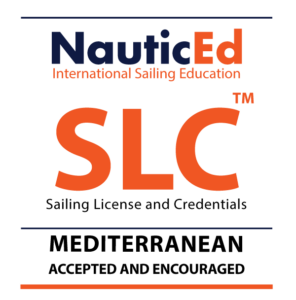Bareboat and International Sailing License (SLC) Self-Assessment
A self-assessment to prepare for practical, in-person, on-the-water assessments with a NauticEd Assessor/Instructor to become licensed to charter boats worldwide.
Jump to the Self-Assessment | Learn more about the SLC International License
This is the SLC Assessment for SAIL | Go to the SLC Assessment for POWER
What is the Bareboat / SLC Self-Assessment?
The SLC Self-Assessment is a tool to “self-assess” and prepare for your practical, on-the-water, skills that are required to bareboat charter a sailboat worldwide with the International Sailing License and Credentials (SLC) license. While the self-assessment is intended to be sent to your Assessor/Instructor, you’re welcome to use it personally.
What is being assessed?
Primarily you’re being assessed for skills competence for multiday and near coastal sailing on large sailboats or catamarans, which not only include large boat handling (under power and sailing) skills, but also systems, navigation, anchoring/mooring, and safety-related skills. Think of it this way: as a skipper, you are the helmsman, sail trimmer, navigator, engineer, electrician, plumber, and even chef – all while confidently leading the crew with knowledge, experience, and expertise.
International Licensing and Bareboat Chartering requires additional knowledge and skill requirements such as different navigational aid systems, Mediterranean Mooring, and even dinghy operations.
Theory-knowledge vs. Practical Assessments
With NauticEd, you learn and are assessed for theory-knowledge online, specifically with the Bareboat Charter Master online courses. Then you can take a practical on-the-water course with a qualified NauticEd instructor, or you can be “assessed” on-the-water (usually takes about a day) to become certified and receive your SLC license. This self-assessment is for the practical assessment with an instructor, not theory-knowledge tested in the online courses.
How is the Bareboat SLC Self-Assessment Used?
Since the Self-Assessment is used to prepare for an in-person and on-the-water assessment by a qualified Assessor/Instructor, it is NOT SCORED. Instead, you (and the instructor if you send it) will receive an emailed list of (a) areas in which you need help, (b) areas wherein you may be a bit rusty, and (c) all the glorious skills that you have mastered.
Your Assessor/Instructor then can discuss the results with you in detail. For example, perhaps you need more practice to “shake off the rust” (if you haven’t sailed in a while), or for some items you may want a refresher or additional training.
Why is the Bareboat SLC Self-Assessment Important?
The SLC in-person, on-the-water, assessment with an Assessor/Instructor is PASS/FAIL. The NauticEd assessor does not pass or fail based on opinion; rather, they evaluate whether your demonstrated skills meet national and international benchmarks.
Simply, it behooves you to self-assess so that you can fully prepare for the actual assessment. And even if you’re just “monkeying around” with this form, it’ll give you an excellent sense of your strengths and weaknesses when it comes to chartering a boat internationally.
Important Assessment Points to Keep in Mind:
- The SLC is not a casual certification—it is an international sailing license that requires verified competence.
- The assessor’s job is not only to evaluate you, but also to help identify any critical weaknesses that may put you, your crew, or your vessel at risk.
- Attempting to “rush” the assessment by overstating your abilities may result in not passing and the need for additional assessment and training sessions.
- It is completely acceptable and encouraged to indicate areas where you need a refresher or further instruction. Doing so shows maturity, responsibility, and dedication to becoming a competent skipper.
- Should your session include more training time, you will leave a more confident and capable boater—and ultimately safer and more qualified for bareboat charter operations.
Give Yourself an Honest Assessment
By “honest” we mean giving yourself a candid and realistic evaluation of your strengths, weaknesses, and areas for improvement – with the goal of growth and becoming a competent boater. Being honest with your self-assessment before working with a boating assessor or instructor is crucial for your growth and safety. It helps the instructor tailor the training to your actual needs, reinforce weak areas, and build real competence. Overestimating your abilities can slow your progress, create risky situations, or result in a failed license assessment—while an “honest” self-assessment sets you up for a more efficient, personalized learning experience.
SLC Self-Assessment Instructions
1. Complete the Self-Assessment below. Each question has 3 answers to select from. Very simple:
– “I’m Good to Go“: you feel confident and competent with this skill.
– “I’m a Little Rusty“: you are familiar with the skill, but are likely out of practice (i.e., “rusty” and haven’t done it in a while) and are not fully confident in performing the skill in an on-water assessment.
– “I Need Help“: you’re not really confident or practiced in this skill and likely need help with it.
2. When complete, add any additional comments and email info – including the assessor/instructor info (optional) – for a summary.
Note that we’re not collecting your email address for marketing, signing you up for anything, or any of that bait-n-switch nonsense. This is strictly a self-assessment, and results go only to those who you assign at the end.
Please note: the form may “time out” if left open for long periods of time, so please keep this in mind when working on the assessment. This happens because of security reasons as well as certain browser settings, which require a balance between your/our online security and the time needed to complete the assessment. If any issues or questions with the form, please contact us at support@nauticed.org. If an issue, please share details of the issues that you encountered.




